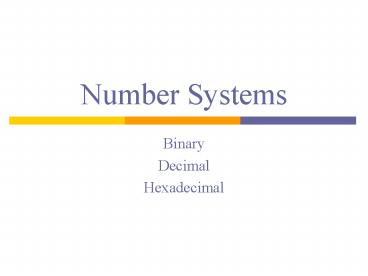Number Systems - PowerPoint PPT Presentation
1 / 25
Title:
Number Systems
Description:
Unit Symbol Number of Bytes. kilobyte. megabyte. gigabyte. terabyte. Bit Permutations ... Because we use 16 symbols, the digits 0 through 9 and the letters A ... – PowerPoint PPT presentation
Number of Views:64
Avg rating:3.0/5.0
Title: Number Systems
1
Number Systems
- Binary
- Decimal
- Hexadecimal
2
Bits, Bytes, and Words
- A bit is a single binary digit (a 1 or 0).
- A byte is 8 bits
- A word is 32 bits or 4 bytes
- Long word 8 bytes 64 bits
- Quad word 16 bytes 128 bits
- Programming languages use these standard number
of bits when organizing data storage and access.
3
Bits, Bytes
4
Bit Permutations
- 1 bit(only 1 light bulb )
Option2
1
5
Bit Permutations - 2 bit
6
Bit Permutations - 3 bit
7
Bit Permutations - 4 bit (animation)
A
B
C
D
Done!!!
8
Bit Permutations - 4 bit
9
Bit Permutations
10
Number Systems
- The on and off states of the capacitors in RAM
can be thought of as the values 1 and 0,
respectively. - Therefore, thinking about how information is
stored in RAM requires knowledge of the binary
(base 2) number system. - Lets review the decimal (base 10) number system
first.
11
The Decimal Number System
- The decimal number system is a positional number
system. - Example
- 5 6 2 1 1 X 100 1
- 103 102 101 100 2 X 101 20
- 6 X 102 600
- 5 X 103 5000
12
The Decimal Number System (cont)
- The decimal number system is also known as base
10. - The values of the positions are calculated by
taking 10 to some power. - Why is the base 10 for decimal numbers?
- Because we use 10 digits, the digits 0 through 9.
13
The Binary Number System
- The binary number system is also known as base 2.
The values of the positions are calculated by
taking 2 to some power. - Why is the base 2 for binary numbers?
- Because we use 2 digits, the digits 0 and 1.
14
The Binary Number System
- The binary number system is also a positional
numbering system. - Instead of using ten digits, 0 - 9, the binary
system uses only two digits, 0 and 1. - Example of a binary number and the values of the
positions
- 1 0 0 1 1 0 1
- 26 25 24 23 22 21 20
15
Converting from Binary to Decimal
- 1 0 0 1 1 0 1
- 26 25 24 23 22 21 20
16
Converting From Decimal to Binary
- Make a list of the binary place values up to the
number being converted. - Perform successive divisions by 2, placing the
remainder of 0 or 1 in each of the positions from
right to left. - Continue until the quotient is zero.
- Example 4210
17
Adding Binary
18
Working with Large Numbers
- 0 1 0 1 0 0 0 0 1 0 1 0 0 1 1 1 ?
- Humans cant work well with binary numbers there
are too many digits to deal with. - Memory addresses and other data can be quite
large. Therefore, we sometimes use the
hexadecimal number system.
19
The Hexadecimal Number System
- The hexadecimal number system is also known as
base 16. The values of the positions are
calculated by taking 16 to some power. - Why is the base 16 for hexadecimal numbers ?
- Because we use 16 symbols, the digits 0 through 9
and the letters A through F.
20
The Hexadecimal Number System
- Binary Decimal Hexadecimal Binary
Decimal Hexadecimal - 0 0 0
1010 10 A - 1 1 1
1011 11 B - 10 2 2
1100 12 C - 11 3 3
1101 13 D - 100 4 4
1110 14 E - 101 5 5
1111 15 F - 110 6 6
- 111 7 7
- 1000 8 8
- 1001 9 9
21
The Hexadecimal Number System
- 0, 1, 2, 3, 4, 5, 6, 7, 8, 9, a, b, c, d, e, f,
- 10, 11, 12, 13, 14, 15, 16, 17, 18, 19, 1a, 1b,
1c, 1d, 1e, 1f, 20 - Example of a hexadecimal number and the values of
the positions - 3 C 8 B 0 5 1
- 166 165 164 163 162 161
160
22
Hex could be fun!
- ACE
- AD0BE
- BEE
- CAB
- CAFE
- C0FFEE
- DECADE
- Note 0 is a zero not and a letter O
23
Hexadecimal Multiplication Table
24
Example of Equivalent Numbers
- Binary 1 0 1 0 0 0 0 1 0 1 0 0 1 1 1 (2)
- Decimal 20647 (10)
- Hexadecimal 50A7 (16)
- Notice how the number of digits gets smaller as
the base increases.
25
Converting from Binary to Decimal
- Practice conversions Binary Decimal
- 11101
- 1010101
- 100111
- Practice conversions Decimal Binary
- 59
- 82
- 175































